Author Archives: nkoub
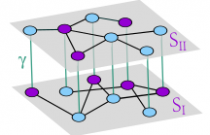
Opinion competition dynamics on multiplex networks
Multilayer and multiplex networks represent a good proxy for the description of social phenomena where social structure is important and can have different origins. Here, we propose a model of opinion competition where individuals are organized according to two different

Opinion competition dynamics on multiplex networks
Multilayer and multiplex networks represent a good proxy for the description of social phenomena where social structure is important and can have different origins. Here, we propose a model of opinion competition where individuals are organized according to two different
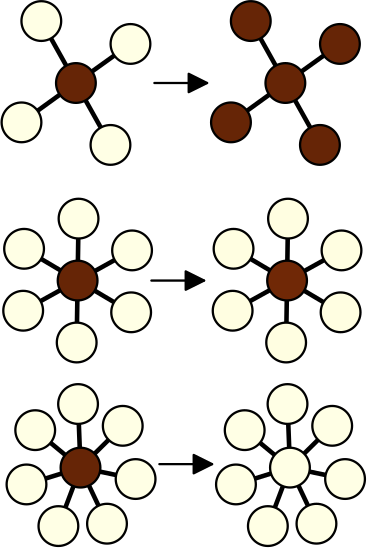
Stationary patterns in star networks of bistable units: Theory and application to chemical reactions
We present theoretical and experimental studies on pattern formation with bistable dynamical units coupled in a star network configuration. By applying a localized perturbation to the central or the peripheral elements, we demonstrate the subsequent spreading, pinning, or retraction of

Stationary patterns in star networks of bistable units: Theory and application to chemical reactions
We present theoretical and experimental studies on pattern formation with bistable dynamical units coupled in a star network configuration. By applying a localized perturbation to the central or the peripheral elements, we demonstrate the subsequent spreading, pinning, or retraction of
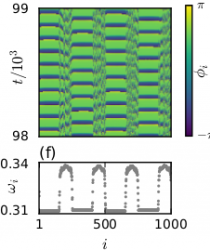
Chimera states in network-organized public goods games with destructive agents
It is shown that a network-organized metapopulation of cooperators, defectors and destructive agents playing the public goods game with mutations, can collectively reach global synchronization or chimera states. Global synchronization is accompanied by a collective periodic burst of cooperation, whereas

Chimera states in network-organized public goods games with destructive agents
It is shown that a network-organized metapopulation of cooperators, defectors and destructive agents playing the public goods game with mutations, can collectively reach global synchronization or chimera states. Global synchronization is accompanied by a collective periodic burst of cooperation, whereas
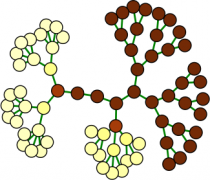
Self-Organized Stationary Patterns in Networks of Bistable Chemical Reactions
Experiments with networks of discrete reactive bistable electrochemical elements organized in regular and nonregular tree networks are presented to confirm an alternative to the Turing mechanism for the formation of self-organized stationary patterns. The results show that the pattern formation

Self-Organized Stationary Patterns in Networks of Bistable Chemical Reactions
Experiments with networks of discrete reactive bistable electrochemical elements organized in regular and nonregular tree networks are presented to confirm an alternative to the Turing mechanism for the formation of self-organized stationary patterns. The results show that the pattern formation
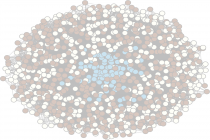
Workshop: “Self-organized patterns on complex networks”, 21 September 2016
Workshop on “Self-Organized Patterns on Complex Networks” 2016 Conference on Complex Systems Amsterdam, 21st September 2016 You are kindly invited to participate to the Workshop on “Self-Organized Patterns on Complex Networks”, that will take place in Amsterdam as a satellite

Workshop: “Self-organized patterns on complex networks”, 21 September 2016
Workshop on “Self-Organized Patterns on Complex Networks” 2016 Conference on Complex Systems Amsterdam, 21st September 2016 You are kindly invited to participate to the Workshop on “Self-Organized Patterns on Complex Networks”, that will take place in Amsterdam as a satellite
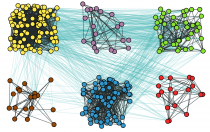
Chimera-like states in modular networks
Inspired by the ancient Greek mythological creature Chimera (χίμαιρα) which had a lion’s head, a goat’s body and a serpent’s tail, Abrams and Strogatz [1] coined the term “chimera states” for the counterintuitive self-organized phenomenon in which synchronous and desynchronous

Chimera-like states in modular networks
Inspired by the ancient Greek mythological creature Chimera (χίμαιρα) which had a lion’s head, a goat’s body and a serpent’s tail, Abrams and Strogatz [1] coined the term “chimera states” for the counterintuitive self-organized phenomenon in which synchronous and desynchronous
Tutorial 5 for WWCS2016
IPython Notebooks for the Tutorial 5 of the Winter Workshop on Complex Systems 2016 This python notebook solves a bistable system on a complex network and visualizes the solution Import networkx library import networkx as nx For the numerical integration
Tutorial 5 for WWCS2016
IPython Notebooks for the Tutorial 5 of the Winter Workshop on Complex Systems 2016 This python notebook solves a bistable system on a complex network and visualizes the solution Import networkx library import networkx as nx For the numerical integration

multiNetX v1.0
multiNetX is a python package for the manipulation and visualization of multilayer networks. The core of this package is a MultilayerGraph, a class that inherits all the features of networkx.Graph(). multiNetX inheriths all features from NetworkX Features: Creating networks with

multiNetX v1.0
multiNetX is a python package for the manipulation and visualization of multilayer networks. The core of this package is a MultilayerGraph, a class that inherits all the features of networkx.Graph(). multiNetX inheriths all features from NetworkX Features: Creating networks with
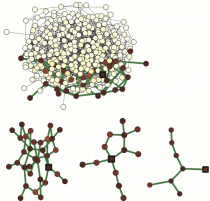
Feedback induced patterns in bistable networks
Effects of feedbacks on self-organization phenomena in networks of diffusively coupled bistable elements are investigated. For regular trees, an approximate analytical theory for localized stationary patterns under application of global feedbacks is constructed. Using it, properties of such patterns in

Feedback induced patterns in bistable networks
Effects of feedbacks on self-organization phenomena in networks of diffusively coupled bistable elements are investigated. For regular trees, an approximate analytical theory for localized stationary patterns under application of global feedbacks is constructed. Using it, properties of such patterns in
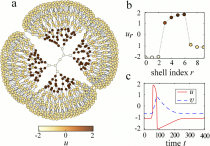
Excitable networks
Excitation waves are studied on trees and random networks of coupled active elements. Undamped propagation of such waves is observed in those networks. It represents an excursion from the resting state and a relaxation back to it for each node.

Excitable networks
Excitation waves are studied on trees and random networks of coupled active elements. Undamped propagation of such waves is observed in those networks. It represents an excursion from the resting state and a relaxation back to it for each node.